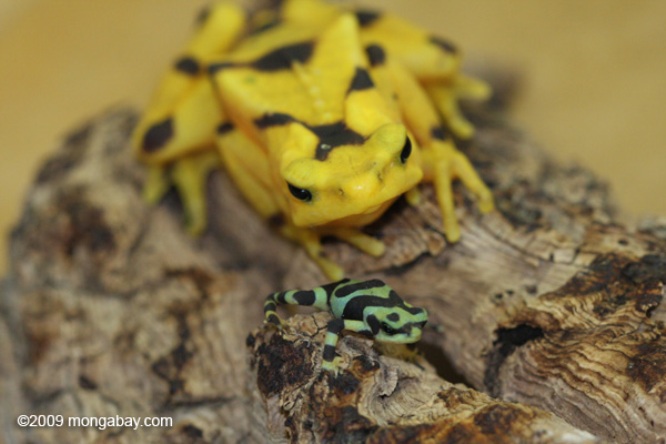Toxicology
The Panamanian Golden Frog is known for the strong toxin it secretes in its skin known as zetekitoxin AB. It is believed by scientists that the toxicity levels of the frog are directly related to the vibrancy of the frog's color. In the infant stage, the frogs do not have much yellow coloring and are primarily green and black meaning they have low levels of toxicity. In the adult stage, the frogs develop an extremely vibrant yellow color with black spots signifying that their toxin is much more potent. This is seen in the photograph below.

Courtesy of
www.mongabay.com
Photo taken by Rhett Butler
Originally known as Atelopidtoxin, the guanidium toxin found in the skin of Panamanian Golden Frogs was relatively unknown structure-wise to the scientific community. It was then analyzed to a further degree which proved it to be a saxitoxin analog with much more potency than saxitoxin itself. Subsequently, the toxin was renamed to zetekitoxin AB because of its exclusiveness to the species Atelopus zeteki. The primary characteristic of this toxin is its ability to obstruct the voltage-dependent sodium channels in brain, heart, and muscle tissues to a much greater degree than saxitoxin. All of the toxin present in the skin of one frog would have the capability to kill approximately 1,200 mice each with a mass of 20 grams.
Zetekitoxin AB's structure is quite sophisticated as shown in the diagram below (right). As you can see, zetekitoxin AB has multiple analogous atomic characteristics to the saxitoxin structure.

Image created by Bryan Johnson
Saxitoxin molecular structure.
Zetekitoxin AB molecular structure. Analagous to zetekitoxin AB
(right). Analogous
to saxitoxin (left).
Check out Ginkgo biloba, otherwise known as the Maidenhair Tree. It incorporates toxicity into the world of plants!
Note: Unless labeled, all images used under public permission.
To continue on to the Panamanian Golden Frog's nutrition, click here.
Are you lost? Go back HOME.
